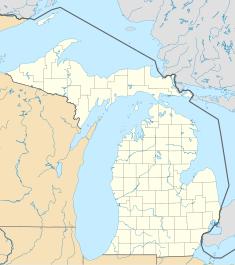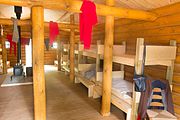
Kalamazoo is a city in the southwest region of the U.S. state of Michigan. It is the county seat of Kalamazoo County. At the 2010 census, Kalamazoo had a population of 74,262. Kalamazoo is the major city of the Kalamazoo-Portage Metropolitan Statistical Area, which had a population of 335,340 in 2015. Kalamazoo is equidistant from Chicago and Detroit, being about 140 miles (230 km) away from both.

Muskegon, a city in the US. state of Michigan, is the county seat of Muskegon County. Situated around a harbor of Lake Michigan, Muskegon is known for fishing, sailing regattas, and pleasure boating, and as a commercial- and cruise-ship port. It is a popular vacation destination because of the expansive freshwater beaches, historic architecture, and public art collection. It is the most populous city along Lake Michigan's Eastern shore. At the 2020 United States Census, the city's population was 38,318. The southwest corner of Muskegon Township, the city is administratively autonomous.

Whitehall is a city in Muskegon County in the U.S. state of Michigan. The population was 2,706 at the 2010 census. The city is located in the southwest corner of Whitehall Township. Montague is its neighbor.
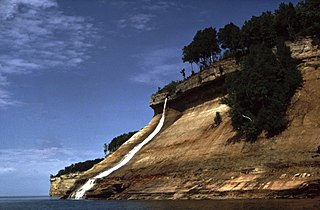
Pictured Rocks National Lakeshore is a U.S. National Lakeshore in the Upper Peninsula of Michigan, United States. It extends for 42 miles (67 km) along the shore of Lake Superior and covers 73,236 acres. The park has extensive views of the hilly shoreline between Munising and Grand Marais in Alger County, with picturesque rock formations, waterfalls, and sand dunes.
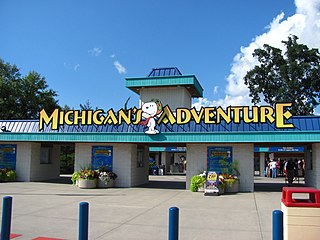
Michigan's Adventure is a 250-acre (1.0 km2) amusement park in Muskegon County, Michigan, about halfway between Muskegon and Whitehall. It is the largest amusement park in the state and has been owned and operated by Cedar Fair since 2001. As of 2022, Michigan's Adventure has 37 rides, more than any other park in the state.
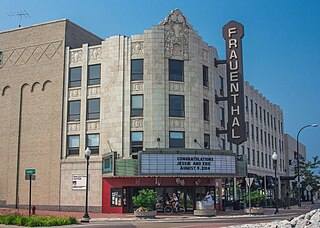
The Frauenthal Center for Performing Arts is located in downtown Muskegon in the U.S. state of Michigan. It consists of the Frauenthal Theater, formerly the Michigan Theater, and additional performance, exhibition, and support spaces in the Hilt Building. The Frauenthal Theater opened as the Michigan Theater in 1930, and was one of 17 theaters in downtown Muskegon. Today, it serves as a cultural center for Muskegon, under the management of the Community Foundation for Muskegon County.
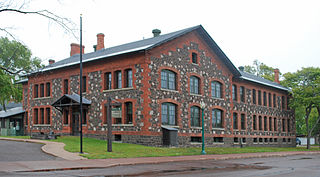
Keweenaw National Historical Park is a unit of the U.S. National Park Service. Established in 1992, the park celebrates the life and history of the Keweenaw Peninsula in the Upper Peninsula of the U.S. state of Michigan. As of 2009, it is a partly privatized park made up of two primary units, the Calumet Unit and the Quincy Unit, and 21 cooperating "Heritage Sites" located on federal, state, and privately owned land in and around the Keweenaw Peninsula. The National Park Service owns approximately 1,700 acres (690 ha) in the Calumet and Quincy Units. Units are located in Baraga, Houghton, Keweenaw, and Ontonagon counties.

Unity Christian Music Festival (Unity) is a four-day Christian music festival held annually during the month of August at Heritage Landing in Muskegon, Michigan.

Hartwick Pines State Park is a public recreation area covering 9,762 acres (3,951 ha) in Crawford County near Grayling and Interstate 75 on the Lower Peninsula of the U.S. state of Michigan. The state park contains an old-growth forest of white pines and red pines, known as the Hartwick Pines. It is claimed by the Michigan Department of Natural resources that this old growth area, along with the Red Pine Natural Area Preserve in Roscommon County resembles the appearance of all Northern Michigan prior to the logging era. These areas do, however, lack the reoccurring low intensity fires which once occurred throughout northern Michigan, impacting regeneration of red pine and eastern hemlock, as well as leading to an increased content of hardwood species such as sugar maple and beech.
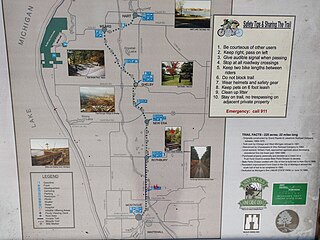
William Field Memorial Hart–Montague Trail State Park, previously and more commonly known as Hart–Montague Trail State Park, is a linear state park in Michigan that consists of a bicycle trail running from the city of Montague in Muskegon County to the city of Hart in Oceana County. The trail is very easy to ride, as it was built on former Chicago & West Michigan railroad right of way with a very low grade. The trail is also very popular for snowmobiles in the winter months.

Muskegon Lake is a 4,150-acre (16.8 km2) fresh-water lake in Muskegon County, Michigan, USA. Located in the lower peninsula at the mouth of the Muskegon River, Muskegon Lake forms a 12-square-mile (31 km2) broad harbor along the eastern shoreline of Lake Michigan, approximately 2.5 miles (4.0 km) wide by 5.5 miles (8.9 km) long.
The Miss Michigan competition is the pageant that selects the representative for the state of Michigan in the Miss America pageant. Michigan has won the Miss America crown on five occasions.

Hartley Outdoor Education Center is a member of the Saginaw Intermediate School District located 1.5 miles (2.4 km) northwest of St. Charles, Michigan in Saginaw County. Since its opening in 1975, Hartley's 300 acres (1.2 km2) have entertained and educated approximately 250,000 students and houses about 4,000 students each year. It is designed to educate elementary and middle school students, but is not limited to this and can teach high school students as well. As both a camp and a school, many students learn topics they normally wouldn't learn inside a classroom, by going through cabins, coal mines, forests, wetlands, meadows and ponds to learn about topics such as survival, pioneer living, or confidence, enjoying themselves in the process.

Palmer Park is a 296-acre (120 ha) public park next to Detroit, Michigan's Palmer Park Apartment Building Historic District. It is named for U.S. Senator Thomas Witherell Palmer, who initially created the park when he donated 140-acre (57 ha) for a city park in 1893 on the condition that the virgin forest be preserved. A 2014 review of Library of Congress records confirmed the existence of a long forgotten sketch for part of Palmer Park by famed landscape architect Frederick Law Olmsted Sr. The park includes a historic log cabin, a public disc golf course, tennis courts, hiking and biking trails and a large pond known as Lake Frances.

Gerber Scout Reservation (GSR), located in Twin Lake, Michigan is a resident camp owned and operated by the Michigan Crossroads Council of the Boy Scouts of America. It began operation in 1950 and had its first official summer camp program in 1951. The Original property was purchased through a gift of 275 shares from Dan Gerber, President of the famous baby food company. The reservation operates two camps; Gerber Scout Camp and the Betty Ford Cub Scout and Webelos Adventureland, as well as numerous year round weekend programming outside of the summer months.
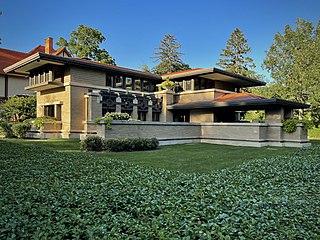
Grand Rapids is a city and county seat of Kent County in the U.S. state of Michigan. At the 2020 census, the city had a population of 198,917 which ranks it as the second most-populated city in the state after Detroit. Grand Rapids is the central city of the Grand Rapids metropolitan area, which has a population of 1,087,592 and a combined statistical area population of 1,383,918.

The University of Michigan Museum of Natural History is a natural history museum of the University of Michigan in Ann Arbor, Michigan, United States.

The Great Smoky Mountains Heritage Center is a private non-profit museum located in Townsend, Tennessee, United States, near the city's entrance to the Great Smoky Mountains National Park. Its mission is to preserve the heritage and culture of the inhabitants of the Great Smoky Mountains, including both the region's Native American inhabitants and the pioneers and residents of the region's Appalachian communities. The center was organized in the early 2000s, and officially opened in February 2006.
Mercy Health is a not-for-profit, integrated, managed care health care organization based in West Michigan. On April 13, 2022, Mercy Health announced it was changing its name to Trinity Health Michigan. Facilities include hospitals, treatment facilities, urgent-care facilities, as well as physician practices that serve the western Michigan area. Mercy Health is a member of the Catholic Trinity Health system.
Jessica Lynn Heeringa disappeared from the Exxon gas station where she was working the late shift in Norton Shores, Michigan, United States, on April 26, 2013.
